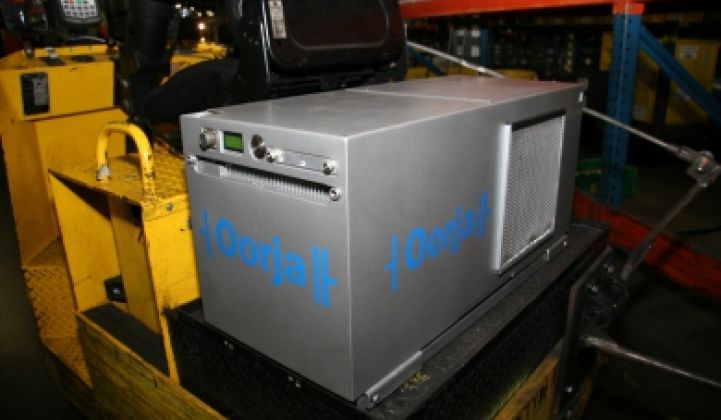Fuel cells – laugh if you want but in some markets they are apparently on the rise.
Nissan will replace 70 chargers for conventional battery-powered tugs – little cars for moving stuff around factories – with 60 methanol fuel cells from Oorja Protonics at its Smyrna, Tenn. factory. The automaker, which has tested out the methanol fuel cells for 18 months, will add 30 more next year, said Mark Sorgi, manager of material handling at Nissan. Other sites may evaluate them as well.
Oorja will also announce more deals with grocery store chains and food distributors in the next few months, said CEO Sanjiv Malhotra. The company will also release a larger, 5-kilowatt fuel cell that can be used to charge the batteries for running the living quarters in big rigs (a market that Firefly Energy pursues with its novel lead acid battery components) and for powering cell phone towers. Deeya Energy, which makes flow batteries, started shipping its cell tower batteries in June.
"It will provide about three times the power of the fork lift" fuel cell, Malhotra said.
The deals Oorja has been landing, in part, stem from the particular dynamics of the market it – and competitors – are tackling. Forklifts and other industrial vehicles are relatively slow, lumbering vehicles that often drive indoors and rarely venture far from a central station. (See me get thrown off of one in this video.) Diesel engines won't work in a lot of locations because the fumes would get trapped indoors.
Grocery stores and factories, thus, rely on forklifts loaded with lead-acid batteries. A lead-acid battery pack, however, can only power a forklift for about four hours. As a result, companies have to buy lots of extra batteries, appoint employees to run charging stations and carve out large areas to serve as a charging bay.
Oorja's OorjaPac fuel cell sits on the fork lift and funnels electrons to the battery pack, charging it as the day progresses. Filling up the fuel cell at the beginning of a shift, ideally, provides enough power for the day. The charging infrastructure – otherwise known as a pump – costs less than a tenth of what a battery bay will run, claims Oorja.
For its part, Nissan will save around $300,000 next year by not having to buy more batteries and $225,000 a year in operating costs, said Sorgi. In all, the methanol fuel cells save about 35 hours a day in employee time: four employees in the battery bay are being deployed.
Competition looms. A few other companies like PlugPower have launched methanol fuel cells for forklifts while several Japanese giants – Kawasaki, Toshiba – have discussed plans to bring nickel metal hydride or lithium-ion batteries to forklifts. Presumably, these longer lasting batteries wouldn't need ride-along chargers.
Like some of its other competitors, Oorja does not participate in the fuel cell market for personal electronics, which have been a tough sell. PolyFuel, which touted methanol fuel cell components that could be used in things like notebooks, went out of business earlier this month. The parent company of MTI MicroFuel Cells got de-listed in May. And these are the methanol companies: The hydrogen fuel cell guys are having even a harder struggle.
At the same time, Oorja has improved the performance of its fuel cell. The new 1.6-kilowatt Model H is about 25 percent to 30 percent smaller than the previous version, at $16,000 costs about 50 percent less than the earlier version, and can be refilled with methanol in about a minute.
"We have reduced the number of components by 35 percent," Malhotra added. "Assembly time is way down. You can install it [on a forklift] in about 15 minutes."
As part of its expansion plans, Oorja is scouting out factory locations near Stockton, Calif.
Learn how to differentiate your company through greener product lines at Greening the Supply Chain on September 17 in Boston.




